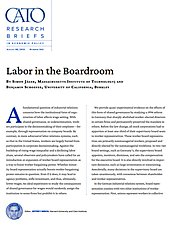A fundamental question of industrial relations concerns how the institutional form of organization of labor affects wage setting. With shared governance, or codetermination, workers participate in the decisionmaking of their employer—for example, through representation on company boards. By contrast, in more adversarial labor relations systems, such as that in the United States, workers are largely barred from participation in corporate decisionmaking. Against the backdrop of rising wage inequality and a declining labor share, several observers and policymakers have called for an introduction or expansion of worker board representation as a way to boost worker bargaining power. Whether minority board representation actually boosts worker bargaining power remains in question. Even if it does, it may lead to agency problems, stifle investment, and thus, ultimately, lower wages. An ideal experiment to study the consequences of shared governance for wages would randomly assign the institution to some firms but prohibit it in others.
We provide quasi-experimental evidence on the effects of this form of shared governance by studying a 1994 reform in Germany that sharply abolished worker-elected directors in certain firms and permanently preserved the mandate in others. Before the law change, all stock corporations had to apportion at least one-third of their supervisory board seats to worker representatives. These worker board representatives are primarily nonmanagerial workers, proposed and directly elected by the nonmanagerial workforce. In two-tier board settings, such as Germany’s, the supervisory board appoints, monitors, dismisses, and sets the compensation for the executive board. It is also directly involved in important decisions, such as large investments or outsourcing. Anecdotally, many decisions in the supervisory board are taken unanimously, with consensus between shareholder and worker representatives.
In the German industrial relations system, board representation coexists with two other institutions of worker representation. First, unions represent workers in collective bargaining negotiations, determining wage floors and hours, usually at the sector-region level. Second, works councils provide shop-floor representation and a separate form of codetermination, such as regarding working conditions or layoff decisions. In many cases, board representatives also serve on works councils. Our analysis includes a test for interactions of board representation with these two institutions.
The 1994 reform abruptly abolished worker-elected directors in new stock corporations (unless firm size crossed a threshold of 500 employees). Importantly, the cohort-based reform locked in shared governance in the incumbent firm cohorts incorporated before the reform. The sharp law change permits us to identify the effect of shared governance by comparing stock corporations incorporated just before and after the August 1994 cutoff. We implement this design by combining firm‑, establishment‑, and worker-level data.
Our main finding is that mandating shared governance does not lead firms to pay measurably higher wages. We estimate small positive effects on composition-adjusted wage premia at the firm, with point estimates between 0.4 and 2.3 percent. We also do not find effects on the wage structure inside the firm or on measures of within-firm pay inequality. We find no evidence for increases in the labor share.
We provide three additional analyses to understand the absence of wage effects. First, we reject the possibility that wages did not increase on net, because the bargaining power increase was offset by a tantamount decrease in the size of the firm’s pie, much like a distortionary profit tax, thus depressing capital formation. In the data, we find that firms with shared governance produce, if anything, higher output, with an extra value-added per worker (labor productivity) of 2–8 percent. Shared governance leads to larger fixed capital stocks and higher capital-labor ratios. We also find no evidence for reductions in revenue or employment. Second, we directly estimate and compare rent-sharing elasticities in firms with and without this form of shared governance. Our findings indicate that worker representation does not appear to raise worker bargaining power over wages. Third, we do not find larger effects in industries where works councils are more prevalent, in high-rent industries, or in industries with low coverage of collective bargaining agreements and large revealed wage dispersion. The lack of heterogeneity in wage effects also suggests that our findings may extend beyond institutional settings similar to Germany.
NOTE
This research brief is based on Simon Jäger, Benjamin Schoefer, and Jörg Heining, “Labor in the Boardroom,” October 2020, economics.mit.edu/files/17273.

This work is licensed under a Creative Commons Attribution-NonCommercial-ShareAlike 4.0 International License.


